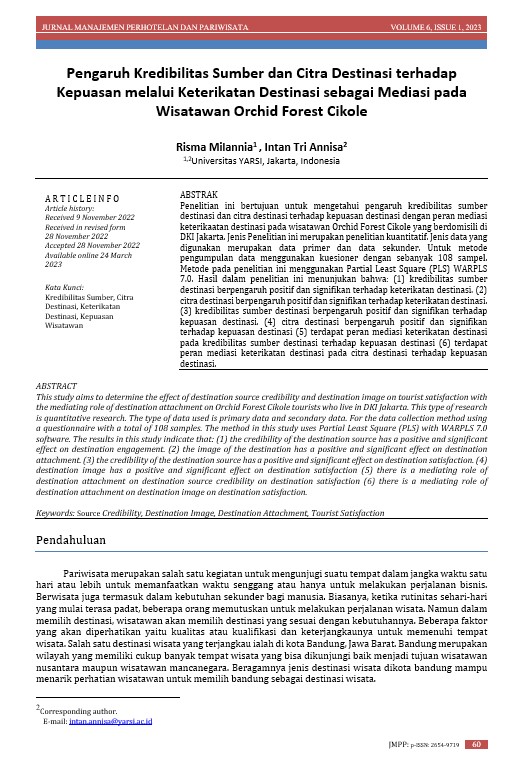Pengaruh Kredibilitas Sumber dan Citra Destinasi terhadap Kepuasan melalui Keterikatan Destinasi sebagai Mediasi pada Wisatawan Orchid Forest Cikole
DOI:
https://doi.org/10.23887/jmpp.v6i1.53871Keywords:
Kredibilitas Sumber, Citra Destinasi, Keterikatan Destinasi, Kepuasan WisatawanAbstract
Penelitian ini bertujuan untuk mengetahui pengaruh kredibilitas sumber destinasi dan citra destinasi terhadap kepuasan destinasi dengan peran mediasi keterikaatan destinasi pada wisatawan Orchid Forest Cikole yang berdomisili di DKI Jakarta. Jenis Penelitian ini merupakan penelitian kuantitatif. Jenis data yang digunakan merupakan data primer dan data sekunder. Untuk metode pengumpulan data menggunakan kuesioner dengan sebanyak 108 sampel. Metode pada penelitian ini menggunakan Partial Least Square (PLS) WARPLS 7.0. Hasil dalam penelitian ini menunjukan bahwa: (1) kredibilitas sumber destinasi berpengaruh positif dan signifikan terhadap keterikatan destinasi. (2) citra destinasi berpengaruh positif dan signifikan terhadap keterikatan destinasi. (3) kredibilitas sumber destinasi berpengaruh positif dan signifikan terhadap kepuasan destinasi. (4) citra destinasi berpengaruh positif dan signifikan terhadap kepuasan destinasi (5) terdapat peran mediasi keterikatan destinasi pada kredibilitas sumber destinasi terhadap kepuasan destinasi (6) terdapat peran mediasi keterikatan destinasi pada citra destinasi terhadap kepuasan destinasi.
References
Abdillah, W & Jogiyanto. (2015) Partial Least Square – Alternatif Structural Equation Modelling (SEM) dalam Penelitian Bisnis. Yogyakarta: Penerbit Andi
Ali, M., Sajjad, M., . O., & Tariq, B. (2021). Impact of Destination Attractiveness on Tourists’ Attachment with Mediating Role of Destination Image. Journal of Marketing Strategies, 3(3), 171–193. https://doi.org/10.52633/jms.v3i3.97
Assaker, G., & Hallak, R. (2013). Moderating Effects of Tourists’ Novelty-Seeking Tendencies on Destination Image, Visitor Satisfaction, and Short- and Long-Term Revisit Intentions. Journal of Travel Research, 52(5), 600–613. https://doi.org/10.1177/0047287513478497
Chen, C. F., & Phou, S. (2013). A closer look at destination: Image, personality, relationship and loyalty. Tourism Management, 36, 269–278. https://doi.org/10.1016/j.tourman.2012.11.015
Chen, C. F., & Tsai, D. C. (2007). How destination image and evaluative factors affect behavioral intentions? Tourism Management, 28(4), 1115–1122. https://doi.org/10.1016/j.tourman.2006.07.007
Chung, N., & Han, H. (2017). The relationship among tourists’ persuasion, attachment and behavioral changes in social media. Technological Forecasting and Social Change, 123, 370–380. https://doi.org/10.1016/j.techfore.2016.09.005
Correa, G., & Montero, A. V. (2013). No Covariance Structure Analysis of Health-Related Indices for the Elderly at Home with a Focus on Subjective Feelings of Health Title. May, 1–10.
Esch, F. R., Langner, T. L., Schmitt, B. H., & Geus, P. (2006). Are brands forever? How brand knowledge and relationships affect current and future purchases. Journal of Product and Brand Management, 15(2), 98–105. https://doi.org/10.1108/10610420610658938
Ghozali, I., & Latan, H. (2015). Partial least squares: Konsep, teknik, dan aplikasi menggunakan program smart PLS 3.0 (2nd ed.). Semarang: Universitas Dipone-goro Semarang.
Girish, V. G., Park, E., & Lee, C. K. (2021). Testing the influence of destination source credibility, destination image, and destination fascination on the decision-making process: Case of the Cayman Islands. International Journal of Tourism Research, 23(4), 569–580. https://doi.org/10.1002/jtr.2427
Hartono, J.M. 2011. “Konsep dan Aplikasi Struktural Equattion Modelling Berbasis Varian Dalam Penelitian Bisnis”, UPP STIM YKPN, Yogyakarta.
Japutra, A. (2020). The relations among attachment styles, destination attachment and destination satisfaction. Current Issues in Tourism, 23(3), 270–275. https://doi.org/10.1080/13683500.2019.1639640
Jeong, Y., & Kim, S. (2019). Exploring a suitable model of destination image: The case of a small-scale recurring sporting event. Asia Pacific Journal of Marketing and Logistics, 31(5), 1287–1307. https://doi.org/10.1108/APJML-10-2018-0441
Kani, Y., Aziz, Y. A., Sambasivan, M., & Bojei, J. (2017). Antecedents and outcomes of destination image of Malaysia. Journal of Hospitality and Tourism Management, 32, 89–98. https://doi.org/10.1016/j.jhtm.2017.05.001
Lam, J. M. S., Ismail, H., & Lee, S. (2020). From desktop to destination: User-generated content platforms, co-created online experiences, destination image and satisfaction. Journal of Destination Marketing and Management, 18(July), 100490. https://doi.org/10.1016/j.jdmm.2020.100490
Phau, I., & Ong, D. (2007). An investigation of the effects of environmental claims in promotional messages for clothing brands. Marketing Intelligence and Planning, 25(7), 772–788. https://doi.org/10.1108/02634500710834214
Prayag, G., & Ryan, C. (2012). Antecedents of tourists’ loyalty to mauritius: The role and influence of destination image, place attachment, personal involvement, and satisfaction. Journal of Travel Research, 51(3), 342–356. https://doi.org/10.1177/0047287511410321
Quenda, I. V. (2019). Pengaruh Citra Destinasi dan Persepsi Harga Terhadap Minat Kunjung Kembali Melalui Kepuasan Wisatawan Studi pada Wisatawan Dunia Fantasi Ancol. Management Analysis Journal, 51(1), 51.
Ramkissoon, H., Graham Smith, L. D., & Weiler, B. (2013). Testing the dimensionality of place attachment and its relationships with place satisfaction and pro-environmental behaviours: A structural equation modelling approach. Tourism Management, 36, 552–566. https://doi.org/10.1016/j.tourman.2012.09.003
Roostika, R., & Muafi, M. (2014). The Role of Source Credibility and Place Attachment in Enhancing Visitors’ Satisfaction. Jurnal Manajemen Teknologi, 13(3), 239–252. https://doi.org/10.12695/jmt.2014.13.3.1
Saini, S., & Arasanmi, C. N. (2021). Attaining digital advocacy behaviour through destination image and satisfaction. International Journal of Tourism Cities, 7(1), 119–134. https://doi.org/10.1108/IJTC-07-2019-0108
Sembiring, A. T. H. (2017). Pengaruh Citra Destinasi Dan Kualitas Pelayanan Terhadap Kepuasan Wisatawan Dan Keputusan Kunjungan Ulang (Studi Kasus Wisatawan Istana Maimoon Medan).
Sohn, H. K., & Yoon, Y. S. (2016). Verification of Destination Attachment and Moderating Effects in the Relationship Between the Perception of and Satisfaction with Tourism Destinations: A Focus on Japanese Tourists. Journal of Travel and Tourism Marketing, 33(5), 757–769. https://doi.org/10.1080/10548408.2016.1167394
Stedman, R. C. (2003). Is it really just a social construction?: The contribution of the physical environment to sense of place. Society and Natural Resources, 16(8), 671–685. https://doi.org/10.1080/08941920309189
Sugiyono, D. (2017). Prof, Statistika Untuk Penelitian. Bandung: Alfabeta Bandung.
Syarkani, Y., Cakranegara, P. A., Ronaldo, R., & Ahmaddien, I. (2022). Pengaruh kredibilitas merek terhadap word of mouth melalui customer satisfaction dan customer loyalty pada Mirota Kampus Yogyakarta. Fair Value: Jurnal Ilmiah Akuntansi dan Keuangan, 4(9), 4099–4105. https://doi.org/10.32670/fairvalue.v4i9.1614
Veasna, S., Wu, W. Y., & Huang, C. H. (2013). The impact of destination source credibility on destination satisfaction: The mediating effects of destination attachment and destination image. Tourism Management, 36, 511–526. https://doi.org/10.1016/j.tourman.2012.09.007
Zhang, J., Byon, K. K., Williams, A. S., & Huang, H. (2019). Effects of the event and its destination image on sport tourists’ attachment and loyalty to a destination: the cases of the Chinese and U.S. Formula One Grand Prix. Asia Pacific Journal of Tourism Research, 24(12), 1169–1185. https://doi.org/10.1080/10941665.2019.1667837










